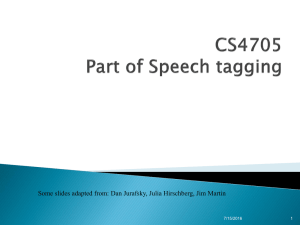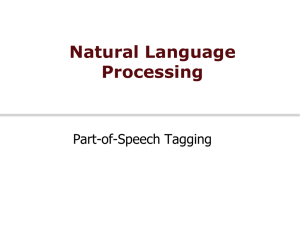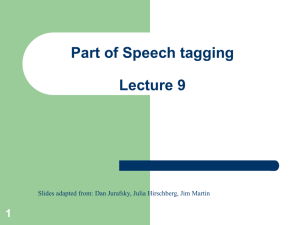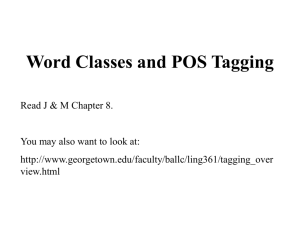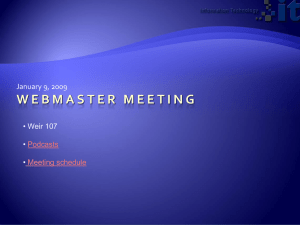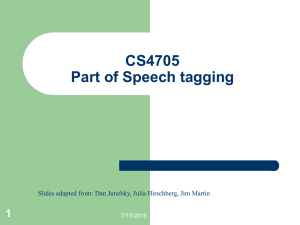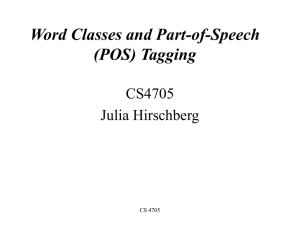CS 4705 Word Classes and Part-of- Speech (POS) Tagging
advertisement
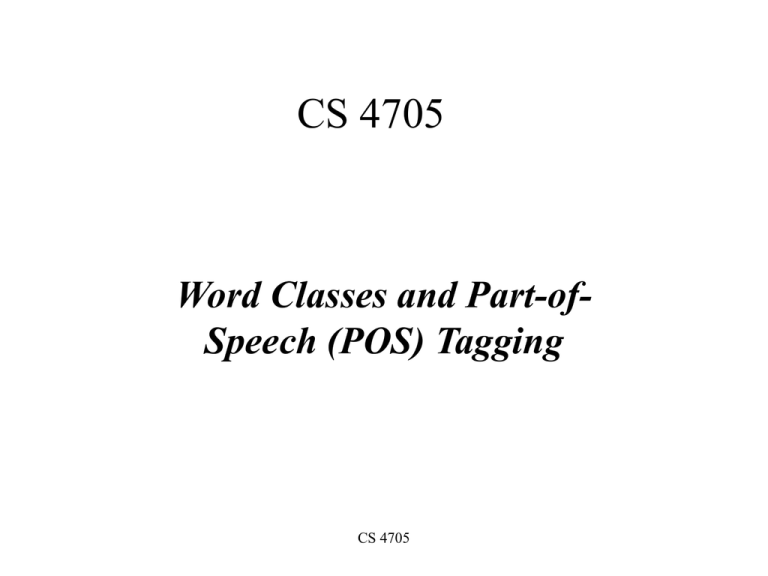
CS 4705 Word Classes and Part-ofSpeech (POS) Tagging CS 4705 What is a word class? • Words that somehow ‘behave’ alike: – Appear in similar contexts – Perform similar functions in sentences – Undergo similar transformations • Why do we want to identify them? – – – – – Pronunciation (desert/desert) Stemming Semantics More accurate N-grams Simple syntactic information How many word classes are there? • A basic set: – N, V, Adj, Adv, Prep, Det, Aux, Part, Conj, Num • A simple division: open/content vs. closed/function – Open: N, V, Adj, Adv – Closed: Prep, Det, Aux, Part, Conj, Num • Many subclasses, e.g. – eats/V eat/VB, eat/VBP, eats/VBZ, ate/VBD, eaten/VBN, eating/VBG, ... – Reflect morphological form & syntactic function How do we decide which words go in which classes? • Nouns denote people, places and things and can be preceded by articles? But… My typing is very bad. *The Mary loves John. • Verbs are used to refer to actions and processes – But some are closed class and some are open I will have emailed everyone by noon. • Adjectives describe properties or qualities, but a cat sitter, a child seat • Adverbs include locatives (here), degree modifiers (very), manner adverbs (gingerly) and temporals (today) – Is Monday a temporal adverb or a noun? • Closed class items (Prep, Det, Pron, Conj, Aux, Part, Num) are easier, since we can enumerate them….but – Part vs. Prep • George eats up his dinner/George eats his dinner up. • George eats up the street/*George eats the street up. – Articles come in 2 flavors: definite (the) and indefinite (a, an) – Conjunctions also have 2 varieties, coordinate (and, but) and subordinate/complementizers (that, because, unless,…) – Pronouns may be personal (I, he,...), possessive (my, his), or wh (who, whom,...) – Auxiliary verbs include the copula (be), do, have and their variants plus the modals (can, will, shall,…) • And more… – Interjections/discourse markers – Existential there – Greetings, politeness terms So how do we choose a Tagset? • Brown Corpus (Francis & Kucera ‘82), 1M words, 87 tags • Penn Treebank: hand-annotated corpus of Wall Street Journal, 1M words, 45-46 tags • How do tagsets differ? – Degree of granularity – Idiosyncratic decisions, e.g. Penn Treebank doesn’t distinguish to/Prep from to/Inf, eg. – I/PP want/VBP to/TO go/VB to/TO Zanzibar/NNP ./. – Don’t tag it if you can recover from word (e.g. do forms) Part-of-Speech Tagging • How do we assign POS tags to words in a sentence? – – – – – – – Get/V the/Det bass/N Time flies like an arrow. Time/[V,N] flies/[V,N] like/[V,Prep] an/Det arrow/N Time/N flies/V like/Prep an/Det arrow/N Fruit/N flies/N like/V a/DET banana/N Fruit/N flies/V like/Prep a/DET banana/N The/Det flies/N like/V a/DET banana/N Potential Sources of Disambiguation • Many words have only one POS tag (e.g. is, Mary, very, smallest) • Others have a single most likely tag (e.g. a, dog) • But tags also tend to co-occur regularly with other tags (e.g. Det, N) • In addition to conditional probabilities of words P(w1|wn-1), we can look at POS likelihoods P(t1|tn1) to disambiguate sentences and to assess sentence likelihoods Approaches to POS Tagging • Hand-written rules • Statistical approaches • Hybrid systems (e.g. Brill’s transformation-based learning) Statistical POS Tagging • Goal: choose the best sequence of tags T for a sequence of words W in a sentence T ' arg max P(T |W ) – T – By Bayes Rule P(T |W ) P(T )P(W |T ) P(W ) – Since we can ignore P(W), we have T ' arg max P(T )P(W |T ) T Statistical POS Tagging P(T) = P(t1, t2, …, tn-1 , tn) By the Chain Rule: = P(tn | t1, …, tn-1 ) P(t1, …, tn-1) n = P(ti |t1i 1) i1 Making the Markov assumption: n P(ti |ti 1 ) e.g., for bigrams, P(ti |ti 1) i N 1 i1 Statistical POS Tagging P(W|T) = P(w1, w2, …, wn | t1, t2, …, tn ) From the Chain Rule: n = P(wi |w1t1...wi 1ti 1ti) i1 Simplifying assumption: probability of a word depends only on its own tag P(wi|ti) n P(wi |ti) i1 So...multiplying the priors by the likelihoods… n n T ' arg max P(ti |ti 1) P(wi |ti) T i1 i1 Estimating the Tag Priors and Lexical Likelihoods from Corpus • Maximum-Likelihood Estimation – For bigrams: P (ti|ti-1) = c(ti-1, ti )/c(ti-1 ) c(w ,t ) P(wi| ti) = c(t ) i i i Brill Tagging: TBL • Start with simple (less accurate) rules…learn better ones from tagged corpus – Tag each word initially with most likely POS – Examine set of transformations to see which improves tagging decisions compared to tagged corpus – Re-tag corpus – Repeat until, e.g., performance doesn’t improve – Result: tagging procedure which can be applied to new, untagged text An Example The horse raced past the barn fell. The/DT horse/NN raced/VBN past/IN the/DT barn/NN fell/VBD ./. 1) Tag every word with most likely tag and score The/DT horse/NN raced/VBD past/NN the/DT barn/NN fell/VBD ./. 2) For each template, try every instantiation (e.g. Change VBN to VBD when the preceding word is tagged NN, add rule to ruleset, retag corpus, and score 3) Stop when no transformation improves score 4) Result: set of transformation rules which can be applied to new, untagged data (after initializing with most common tag) ….What problems will this process run into? Methodology: Evaluation • For any NLP problem, we need to know how to evaluate our solutions • Possible Gold Standards -- ceiling: – Annotated naturally occurring corpus – Human task performance (96-7%) • How well do humans agree? • Kappa statistic: avg pairwise agreement corrected for chance agreement – Can be hard to obtain for some tasks: sometimes humans don’t agree • Baseline: how well does simple method do? – For tagging, most common tag for each word (91%) – How much improvement do we get over baseline? Methodology: Error Analysis • Confusion matrix: – E.g. which tags did we most often confuse with which other tags? – How much of the overall error does each confusion account for? More Complex Issues • Tag indeterminacy: when ‘truth’ isn’t clear Carribean cooking, child seat • Tagging multipart words wouldn’t --> would/MD n’t/RB • Unknown words – Assume all tags equally likely – Assume same tag distribution as all other singletons in corpus – Use morphology, word length,…. Summary • We can develop statistical methods for identifying the POS of word sequences which reach close to human performance • But not completely “solved” • Next Class: Read Jansche & Abney
